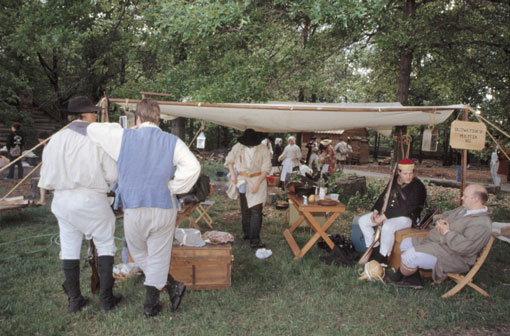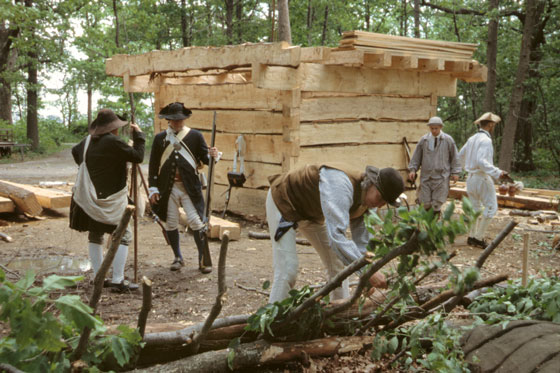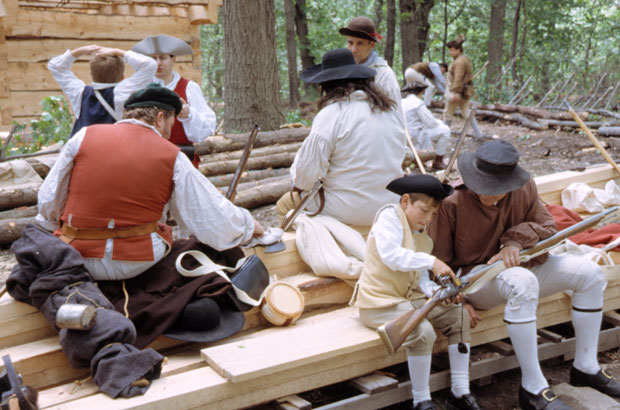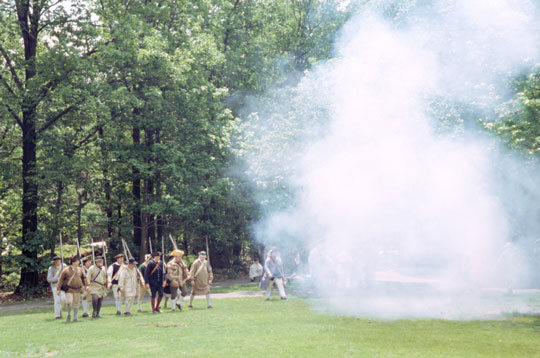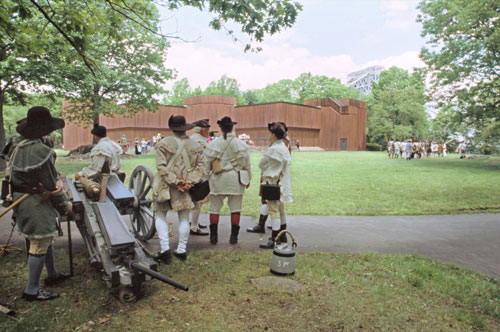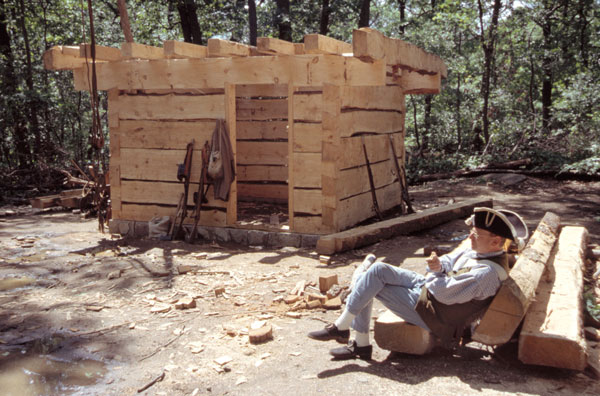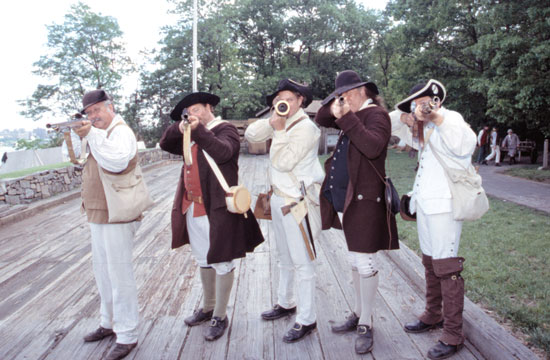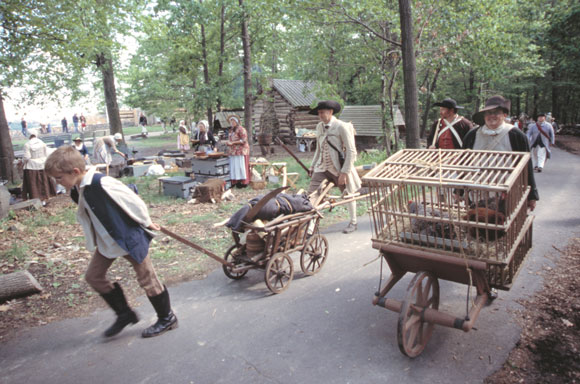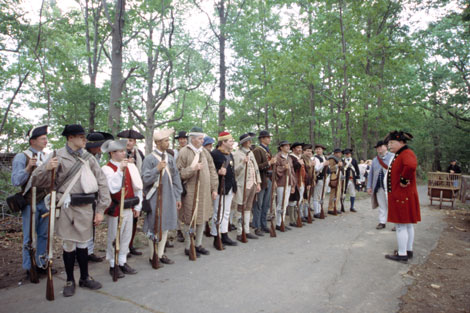American v. American:
The 1781 Battle of Fort Lee
A “Cliff Notes” Story by Todd Braisted
May 2006
For about one week in 1781, the American Revolution centered its vengeance and complexity on Fort Lee, New Jersey. It was not the clash of major armies, but the combat of civil war, as Colonel Theunis Dey’s Bergen County Militia fought against the Loyal Refugee Volunteers under Captain Thomas Ward. Many of Ward’s corps were former Bergen County residents who had been driven from their homes by the new State of New Jersey — hence the term “Refugee.” They were out for vengeance against their former neighbors, the men who made up the militia under Dey.
Many are familiar with the role that Fort Lee played during the 1776 Campaign, when with Fort Washington across the Hudson River, it guarded against British shipping. The fort fell to the British on the morning of November 20, 1776, after which the British demolished most of the works. While the former post and its ferry below would be used in raids into Bergen County, no permanent post was contemplated there. Until 1781.
The New York City area, garrisoned by over 10,000 British, Loyalist, and German troops, along with thousands of Loyalist Refugees — not to mention a large civilian population — consumed large amounts of fuel in the normal course of the year. In the eighteenth century, “fuel” was primarily wood. Thomas Ward’s corps was raised in 1780 to address this need: to cut wood in areas of Bergen County nominally under British control. The corps established a post at Bull’s Ferry, several miles below Fort Lee and north of the British post at Paulus Hook (Jersey City). Despite a dramatic victory over a force of ten times their number under General Anthony Wayne in July of 1780, the corps found the post too dangerous for their taste, and they removed to Bergen Point (Bayonne). At each post the corps built a “blockhouse” for their defense. A blockhouse was a thick wooden structure, generally two stories high, with slits to fire musketry from; often, small cannon were also mounted.
While Bergen Point was better protected against attack, defending the post still took time, and raiding northern Bergen County from this southern outpost was difficult. This, coupled with legal disputes over compensation for the inhabitants whose wood they cut, induced the corps to look for a new post. They chose Fort Lee.
On the morning of May 14, 1781, a fleet of small vessels carrying over two hundred Refugees arrived off Fort Lee. After landing with their artillery and horses, the troops marched into English Neighborhood (as the general area was known) and dispersed a militia picket posted there. A party of militia returned later that day to find the Refugees had started work on a new blockhouse, built upon the remains of old Fort Lee. They commenced firing from a “stone house” a hundred yards away, but the Refugees stormed the house and drove them out.
Colonel Dey, from his home in Preakness (Wayne), put out the call for the militia. In a gathering not seen since the beginning of the war, hundreds of militia flocked from across the county, joined by state troops stationed at Hackensack. They knew a post at Fort Lee would give Ward’s men a perfect vantage point to range far into the countryside, bringing the war into every corner of the county. The fort was, as Private Harman Blauvelt of Harrington recalled it, “a nest of Tories, Refugees and British.”
After rendezvousing at the Liberty Pole in Englewood, Colonel Dey led his men, as many as four hundred, to attack the Refugees at Fort Lee. They engaged in a spirited contest, but the militia was again driven off, once more retiring to Liberty Pole to lick their wounds and count their losses. (Among them was Private John Devoe of Hackensack, who was taken prisoner after being shot, bayoneted, clubbed, and cut down by a cavalryman’s sword. He not only survived his ordeal but was exchanged and serving again in about seven weeks.)
For the next couple of days there was a lull in the fighting — giving Ward and his Refugees a chance to fortify their position. For security, they retired to their ships each night, rather than stay on shore and be open to a surprise attack. Each morning the troops would land from the shipping and march up to the works, probably from the area that is now Edgewater. The militia, taking note of this routine, laid an ambush for them in the defiles leading up to the works. After initially capturing a lieutenant and a private of the Refugees, the militia pursued the fleeing Loyalist advance guard. Ward countered by bringing his artillery to bear on them; this, coupled with a flanking maneuver and bayonet charge, forced the militia to retire from the field. After five days, each side was stalemated: the militia could not force the Refugees away, and the latter could not spend enough time building their blockhouse.
George Washington, from his headquarters at New Windsor, New York, was apprised of the situation by May 17, when he ordered Colonel Alexander Scammell to proceed to Fort Lee and drive off the Refugees. Colonel Scammell was at the time in Westchester County, putting in order a new corps of Continentals formed to handle events such as this. This force proceeded across the river to Nyack, where to their surprise, no food was waiting for them. With no food of their own, Scammell and his men were delayed some time before provisions arrived from West Point.
The British high command in New York City was well aware of the fighting at Fort Lee, as well as Colonel Scammell’s moves and his intention of attacking the Refugees. Sir Henry Clinton, the British commander, ordered almost two thousand crack troops in motion, including cavalry, Hessian riflemen, and the Loyalist New Jersey Volunteers, many of whom were also from Bergen County. Sir Henry at the same time dispatched his adjutant general, Lieutenant Colonel Oliver DeLancey Jr. to Fort Lee to assess the situation for himself. DeLancey reported that the Refugees had made little progress in fortifying their position, and that he doubted their ability to do so in the future. Clinton ordered Ward to cease his efforts and return to their shipping. Grudgingly, the Refugees left Fort Lee for good. The other troops were ordered to return to their quarters, thus ending the chance for a major clash of armies.
Scammell and his men, finally fed, remained unaware that the Refugees were on the point of withdrawing. From Nyack his corps proceeded south as far as Closter, where an immense rain storm not only soaked the men, but wetted their ammunition. There he would have to stay, spending the night in wet clothes, sharing barns with the farmers’ livestock. On the morning of May 22, examining the state of his men and their arms, he determined they were in no shape for any action, and he reluctantly ordered them north to Tappan. He was heartened, however, to hear from an officer he had sent to scout Fort Lee that the Refugees had abandoned their position and were on board their shipping, which by this time had fallen somewhat down the river. Scammell remained in the Tappan area until May 28, when Washington ordered him to return to Westchester.
The Battle of Fort Lee was over.
This series of clashes was not the last of the fighting in Bergen County, but it was the last involving more than five hundred men. Colonel Dey and his men would resume their nightly vigils of keeping guard against Refugee forays. Ward was made a major for his efforts. After establishing a new post to the south of Fort Lee, which was named Fort DeLancey, the Refugees resumed their wood cutting and their raids, striking at such places as New Bridge, Moonachie, English Neighborhood, and Closter. Colonel Scammell would not live to see the end of the war: he was killed during the Siege of Yorktown the following October. Thomas Ward and many of his men would settle on free land provided by the King in Digby, Nova Scotia.
“A Nest of Tories”: Reenactors re-create the events of 1781 at Fort Lee Historic Park, May 2006. Photos by Anthony Taranto.
EN


